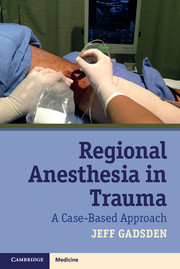Description
Regional Anesthesia in Trauma
A Case-Based Approach
Author: Gadsden Jeff
Language: English
Subject for Regional Anesthesia in Trauma:
Approximative price 36.43 €
In Print (Delivery period: 14 days).
Add to cart
Publication date: 11-2012
146 p. · 15.6x23.5 cm · Paperback
146 p. · 15.6x23.5 cm · Paperback
Description
/li>Contents
/li>Biography
/li>
The management of pain from acute injuries is a priority in trauma care. Regional analgesic techniques are very effective at treating acute pain and are gaining in popularity as recognition of their beneficial effects on morbidity increases. Regional Anesthesia in Trauma employs multiple narrative problem-solving case scenarios that explore the use of regional anesthesia in: ? Blunt chest trauma, amputations, upper and lower extremity fractures and spinal injury ? Burn injury ? Patients with pre-existing nerve injury and other co-morbidities ? Patients at risk for compartment syndrome ? Pregnant, obese, elderly and pediatric patients ? Local anesthetic systemic toxicity With a focus on ultrasound-guided techniques, the reader is guided through the technical aspects of performing regional anesthesia as well as the medical and surgical considerations that influence the choice of analgesic therapy. Regional Anesthesia in Trauma is invaluable for practitioners and trainees in anesthesiology, emergency medicine and trauma surgery.
Preface; 1. Principles of pain management in trauma care; 2. Acute pain, regional anesthesia and the stress response; 3. The progression from acute to chronic pain; 4. Prehospital regional anesthesia; 5. Regional anesthesia and digital replantation; 6. Regional anesthesia and compartment syndrome; 7. Regional anesthesia for blunt chest trauma; 8. Regional anesthesia, trauma, and complex regional pain syndrome; 9. Regional anesthesia and combat care; 10. Regional anesthesia for pediatric trauma; 11. Regional anesthesia for fractured neck of femur; 12. Regional anesthesia in the intoxicated trauma patient; 13. Regional anesthesia for humeral shaft fracture; 14. Regional anesthesia for burns; 15. Regional anesthesia, penetrating abdominal trauma and sepsis; 16. Regional anesthesia in the injured obese patient; 17. Regional anesthesia and lower extremity trauma; 18. Regional anesthesia and traumatic limb amputation; 19. Complications of brachial plexus blockade; 20. Regional anesthesia and trauma in pregnancy; 21. Regional anesthesia and the injured athlete; Index.
Jeff Gadsden is Director of Regional Anesthesia at St Luke's-Roosevelt Hospital Center and Assistant Professor of Clinical Anesthesiology at Columbia University College of Physicians and Surgeons, New York, USA.
© 2024 LAVOISIER S.A.S.




